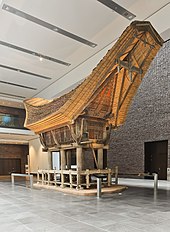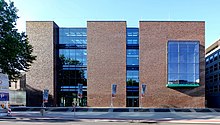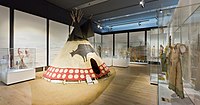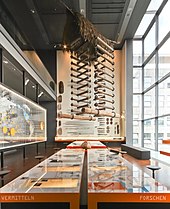Rautenstrauch-Joest-Museum
The Rautenstrauch-Joest-Museum - Cultures of the World in Cologne is the only urban ethnological museum in North Rhine-Westphalia and is located at Cäcilienstraße 29–33, Altstadt-Süd .
On October 22nd, 2010 the reopening of the museum took place in the Kulturquartier am Neumarkt . Museum director has been Nanette Jacomijn Snoep since January 1, 2019 .
History of the collections
The museum has one of the ten largest and most important ethnographic collections in Germany. The collections include more than 65,000 objects from Oceania , Africa , Asia and America .
The basis of the collection is the legacy of the Cologne geographer and ethnologist Wilhelm Joest (1852–1897). Two years after Joest's untimely death on a research trip, his sister Adele Rautenstrauch and her husband, the merchant Eugen von Rautenstrauch, donated their brother's collection of 3,400 objects to the city of Cologne. After the death of her husband, she also supported the construction of the museum at Ubierring 45 with a donation of 250,000 marks , which was opened on November 12, 1906 according to plans by Erwin Crones . The museum building was closed after a bomb hit on February 28, 1945 and only reopened on July 7, 1967. After moving to the newly built cultural quarter on Cäcilienstraße, the museum was reopened on October 22, 2010.
An important addition to the collection since World War II was the acquisition of the collection of oceanic and African art by the Düsseldorf artist Klaus Clausmeyer in 1966 by the City of Cologne. The Cologne banker's son Max von Oppenheim and, more recently, Irene and Peter Ludwig and Hans Wilhelm Siegel also contributed to the collection .
With the reopening in 2010, the exhibition concept was changed from the classic division into large geographical areas to a thematic arrangement. Under the motto “Man in his worlds”, the exhibition shows the following topics in different departments: “Encounter and Appropriation: Crossing Borders”, “The Disguised View: Prejudices”, “The World in the Showcase: Museum”, “Matters of View?!: Art ”,“ Doors in transition ”,“ Living spaces - forms of life: living ”,“ The body as a stage: clothing and jewelry ”,“ The staged farewell: death and afterlife ”,“ Diversity of faith: religions ”,“ Between worlds: rituals ".
This approach, which compares cultures - with the inclusion of European culture - is intended to emphasize the equal existence and equality of all cultures. Dealing with distant cultures should stimulate reflection and relativization of one's own cultural perspective.
Since November 2011, deaf visitors have been able to receive a video guide that leads them through the permanent exhibition. At the information point, they are greeted on a screen with a video in sign language and referred to the video guides that the Rautenstrauch-Joest Museum was the first in Cologne to introduce.
Awards and honors
Since its reopening, the museum has received numerous prizes such as the Cologne Culture Prize Cultural Event of the Year 2010 and the red dot design award 2011. In 2012, the Rautenstrauch-Joest Museum was awarded the Museum Prize of the Council of Europe . In 2013 the museum in Dubrovnik was accepted into the Excellence Club of Best in Heritage , an international platform of the most important museums and projects on cultural heritage.
History of the museum buildings
The museum was located on the Ubierring in a Wilhelminian-style building that was partially destroyed by two bomb hits in World War II. Floods have flooded the museum's depots several times.
In 2002, construction work began on a new museum building based on plans by the Braunschweig architects Schneider + Sendelbach with the demolition of the Josef Haubrich art gallery . Various construction stops and plan changes due to the financial situation of the city of Cologne delayed the completion several times.
On October 22nd, 2010, the museum was reopened in the newly built cultural quarter on Neumarkt .
The new entrance to the neighboring Schnütgen Museum is also located in the cultural quarter . Both buildings are connected by a newly built passage, which also serves to present medieval glass windows. An event hall on the ground floor of the Kulturquartier is used by both museums and the VHS Cologne . The museum shop, the information desk, the cash desk and the cloakroom are also shared.
Exhibition objects (selection)


foyer
- The landmark and largest exhibit in the museum is a magnificently decorated rice granary (approx. 1935) from Sulawesi , Indonesia, over 7.5 m high, which was faithfully rebuilt in the building's foyer.
Attunement: music
- Gamelan orchestra from Central Java , Indonesia, early 20th century
Matters of opinion?!: Art
- Figure of a deity dinonga eidu , Nukuoro, Karolinen, 19th century
- Sculptures minsereh , Mende, Sierra Leone, 19th century
- Paper mask magbo , Yoruba, Nigeria, 19th century
- Fragment of a stele, Piedras Negras , Guatemala, Mayan Late Classical period, AD 662
- Sculpture, Dogon , Tintam Region, Mali, 15th-17th centuries century
- Statue of a deity, Emroin, Babar , Babar Archipelago, Indonesia, 19th century
- Figure of a man in chains, probably Jaina, Campeche, Mexico, Mayan Late Classic, 500–800 AD.
- Sacrificial rack with female ancestor figure luli , Luhuleli, Leti, Indonesia, 19th century
Living spaces - life forms: living
- Tuareg tent, Niger, 2nd half of the 20th century
- Men's house, Atsj, Central Asmat, Western New Guinea, 2nd half of the 20th century
The body as a stage: clothing and jewelry
- Wedding jewelry for a bride, Kabyle, Maghreb, Algeria, 19th century
- Ahu'ula feather coat , Hawaii, Polynesia, before 1824
The staged farewell: death and afterlife
- Portrait vessel, Moche IV, Peru, ca.4th century AD
- Loincloth, Chimú , Peru, c. 1300–1370 AD.
- Dead boat Maori , Bay of Plenty, North Island of New Zealand, 1840
- Twin figures ibeji , Yoruba, Nigeria, early 20th century
Diversity of Beliefs: Religions
- Votive tablet with standing Buddha, Mon, Pegu Empire, Myanmar, 7th – 9th centuries century
- Eleven-headed Bodhisattva Avalokiteshvara , Tibet, southern Tibet, China, 15th / 16th centuries century
- Standing god Shiva , Cambodia, Angkor period, 2nd half of the 9th century
Between worlds: rituals
- Tapuanu mask , Mortlock Islands , Central Carolines, circa 1900
- Mask of the eighteen disease demons Daha Ata Sanni Yaku , southwest coast, Sri Lanka, late 19th century
- Quetzalcoatl - Ehecatl , Central Mexico, Aztec, approx. 1480–1519 AD
Library
The museum has a reference library that is open to the public. This comprises 40,000 monographs and specialist journals , including the scientific literature collection of the founder of the Malayological Apparatus of the University of Cologne , Irene Hilgers-Hesse , who died in 2004 . The German-Indonesian Society handed it to the Museum Library in 2008 as a donation . The holdings include around 1,500 volumes of mainly Indonesian and Malay cultural studies and fiction works (in Latin and Jawi script) from the 1960s to 80s, most of which are otherwise not available in Germany.
Historical photo archive
The historical photo archive includes around 100,000 photographs, including by Rudolf Oldenburg , Marie Pauline Thorbecke , Georg Küppers-Loosen and Albert Grubauer .
Special exhibitions
| Period | title |
|---|---|
| 1981 | Intoxication and Reality, Drugs in a Cultural Comparison (Catalog, edited by Gisela Völger and Karin von Welck, ISBN 3-499-34006-2 ) |
| July 26, 1985 - October 13, 1985 | The bride - loved, sold, bartered, stolen. On the role of women in a cultural comparison |
| April 11, 1987 - July 12, 1987 | Gold and Power - Spain in the New World |
| June 25, 1987 - December 31, 1989 | Ainu - hunters, fishermen and gatherers in northern Japan |
| October 3, 1987 - April 4, 1988 | Splendor and mystery - clothing and jewelry plus from Palestine and Jordan |
| October 21, 1988 - February 26, 1989 | The flight of the boomerang - 40,000 years of Australians |
| March 17, 1989 - September 24, 1989 | Tiger carpets from Tibet |
| March 23, 1990 - June 17, 1990 | Male associations - male bonds: On the role of men in a cultural comparison |
| June 21, 1990 - November 4, 1990 | The robbed shadow - On the history of ethnographic photography in German-speaking countries |
| November 30, 1990 - May 26, 1991 | Niombo - The dead in the doll - funeral rituals in Central Africa |
| July 5, 1991 - January 12, 1992 | Batak - living with the ancestors - people in Indonesia |
| January 15, 1993 - July 25, 1993 | Life in the Russian shtetl - on the trail of An-ski . |
| September 10, 1993 - July 24, 1994 | The other gods - folk and tribal bronzes from India |
| February 18, 1994 - May 23, 1994 | The world of the Maya - archaeological treasures from three millennia |
| May 6, 1994 - June 20, 1994 | Kammerspiel für Völkerkunde - Objects strike back: An art installation by Peter Pick |
| September 30, 1994 - June 5, 1995 | Feather work of the Indians of South America - From the study collection Horst Antes |
| January 19, 1995 - May 7, 1995 | Pictures from Paradise - Colonial Photography from Samoa 1875-1925 |
| September 15, 1995 - October 21, 1995 | Walter Spies - painter and musician in Bali |
| April 25, 1996 - August 31, 1997 | Who has the coconut ...? The coconut palm - tree of a thousand possibilities |
| March 21, 1997 - August 10, 1997 | African Art - The Arman Collection |
| November 25, 1997 - March 8, 1998 | She and He - women's power and male rule in a cultural comparison |
| June 1, 1999 - September 26, 1999 | Soly Cissé - New Art from Senegal. |
| August 13, 1999 - January 31, 2001 | Art of the world |
| October 22, 1999 - January 30, 2000 | Tatau - tattoos from Polynesia |
| June 22, 2000 - October 8, 2000 | From royal courts and sultan's palaces, Gallery Smend collection |
| October 22, 2000 - January 14, 2001 | Amouzou Glikpa - New Art from Togo |
| March 9, 2001 - July 29, 2001 | Sons and Daughters of the Clouds - Displacement and Exile in Western Sahara |
| August 12, 2001 - October 28, 2001 | Between tradition and modernity - young artists from Indonesia |
| December 17, 2001 - November 9, 2003 | Fascination with the Orient - Max von Oppenheim - researcher, collector, diplomat |
| October 11, 2002 - February 26, 2003 | Fascination Africa - Treasures from the Rautenstrauch-Joest-Museum. |
| February 21, 2003 - May 18, 2003 | Life in West Africa |
| October 19, 2003 - January 25, 2004 | Sexuality and Death: AIDS in Contemporary African Art |
| March 7, 2004 - October 3, 2004 | Namibia - Germany: A Shared History |
| February 13, 2005 - October 2, 2005 | Buddhists - Jainas - Hindus: In search of the image of God |
| September 25, 2005 - March 26, 2006 | “Urformen der Kunst”: Photographs by Karl Blossfeldt and non-European art - an exhibition from 1926 in a new light |
| August 7, 2005 - January 13, 2008 | A question of faith: religious diversity in Cologne |
| July 2, 2006 - January 16, 2007 | Trance and Healing - Unknown rituals in India |
| April 22, 2007 - January 13, 2008 | In the shade of the acacia - research in the deserts of Africa |
| November 5, 2010 - March 13, 2011 | Afropolis. City, media, art. |
| April 30, 2011 - September 11, 2011 | Lawrence of Arabia - Genesis of a Myth |
| April 28, 2013 - July 28, 2013 | Albert Watson: - 14 days in Benin |
| October 12, 2013 - April 27, 2014 | Made in Oceania: Tapa - Art and Worlds of Life |
| October 16, 2015 - January 31, 2016 | Madonna meets Uma |
| October 8, 2016 - April 9, 2017 | Pilgrimage - longing for happiness? |
| June 2, 2017 - August 6, 2017 | Crime scene Cambodia? On the trail of a forgery |
| November 10, 2017 - March 4, 2018 | Desert - sea - creator myths. Aboriginal species of the Spinifex and Yolngu |
| March 16, 2018 - June 3, 2018 | "The savage strikes back" - Colonial European depictions from the Lips Collection (a cooperation with the University of Siegen ) |
| October 12, 2018 - February 24, 2019 | Fast fashion. The dark side of fashion (an exhibition by the Museum für Kunst und Gewerbe Hamburg ) |
| February 9, 2019 - April 7, 2019 | in focus: Getting closer. Approaches to Climate Change in East Africa |
| June 7, 2019 - September 22, 2019 | in the spotlight: given! the gift of diplomacy |
| September 27, 2019 - January 5, 2020 | in focus: Delta worlds. Life in unsteady change |
| October 11, 2019 - February 16, 2020 | in focus: saints and ascetics . Miniature painting of the Jaina from India |
| November 1, 2019 - January 5, 2020 | Intervention in the permanent exhibition: 500 years of the conquest of Latin America. Colonialism and Survival Strategies |
Museum directors
The former museum directors were:
- Willy Foy 1901-1925
- Fritz Graebner 1925–1928
- Julius Lips 1928-April 1933
- Andreas Scheller 1933-June 1940 (acting director)
- Martin Heydrich 1940-1945
- Friedrich Wilhelm Funke 1945–1948
- Martin Heydrich 1948–1960
- Willy Fröhlich 1961–1971
- Axel Freiherr von Gagern 1971–1978
- Gisela Völger 1979-2000
- July 1, 2000 to the end of 2018: Klaus Schneider , also professor at the Institute for Social Anthropology at the University of Cologne
- since January 1, 2019: Nanette Jacomijn Snoep
Support association
The RJM museum company has existed since 1901. It finances acquisitions, exhibition and restoration projects. It also supports educational programs, publishes the academic series “Ethnologica” and offers a varied program of events. Volunteers are also involved as employees at the information stand, in the museum shop and as managers.
Ludwig Theodor von Rautenstrauch (1922–2018) held the board of directors of the museum society for 50 years before becoming honorary chairman. The company is managed by the former RWE board member Jan Zilius .
Movies
- Museum check with Markus Brock . Rautenstrauch-Joest-Museum - Museum of Cultures, Cologne . Documentary, Germany, 2013, 29 min., Moderation: Markus Brock, production: 3sat , series: Museums-Check with Markus Brock, first broadcast: October 13, 2013 on 3sat, summary by 3sat.
See also
literature
- Jutta Engelhard and Klaus Schneider (eds.): The human being in his worlds. The new Rautenstrauch-Joest-Museum - cultures of the world . Wienand Verlag, Cologne 2010, ISBN 978-3-86832-035-0 .
- Martin Oehlen: Museums in Cologne . DuMont, Cologne 2004, ISBN 3-8321-7412-5 .
Individual evidence
- ^ Hiltrud Kier : List of monuments . Cologne Neustadt. Ed .: City of Cologne. tape 12.2 . JP Bachem Verlag , Cologne 1983, ISBN 3-7616-0699-0 , p. 186 .
- ^ Gisela Völker (ed.): Art of the world in the Rautenstrauch-Joest-Museum in Cologne. Prestel, Munich 1999, ISBN 3-7913-2179-X .
- ↑ Website of the City of Cologne, notification of September 30, 2013: High honor for the Rautenstrauch-Joest-Museum and website of the City of Cologne: Rautenstrauch-Joest-Museum honored , accessed on July 17, 2017
- ↑ The landmark: a rice granary from Indonesia.
- ↑ Attunement: Gamelan , with detailed catalog text (as PDF) on Gamelan
- ↑ Historical photo archive. Rautenstrauch-Joest-Museum, accessed on March 29, 2012 .
- ↑ archive.nrw.de (with details)
Web links
- Rautenstrauch-Joest-Museum - Cultures of the World
- Support association
- Entire sprinkler system ailing . In: Kölner Stadtanzeiger , January 28, 2014
- Closure for two and a half years threatens . In: Kölnische Rundschau , March 5, 2014
- Our house is understaffed . In: Kölner Stadt-Anzeiger Kultur , December 1, 2018
Coordinates: 50 ° 56 ′ 4.7 ″ N , 6 ° 57 ′ 1.9 ″ E












